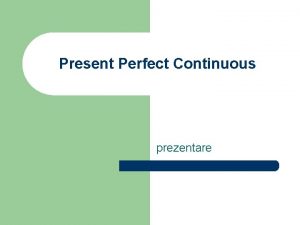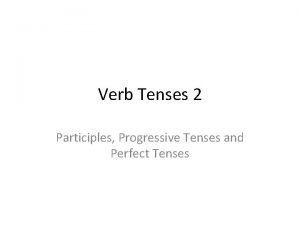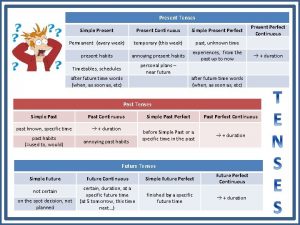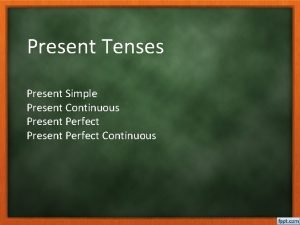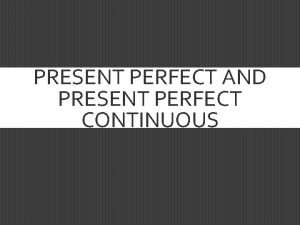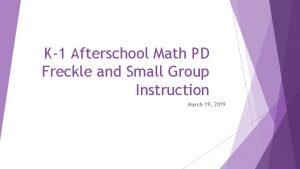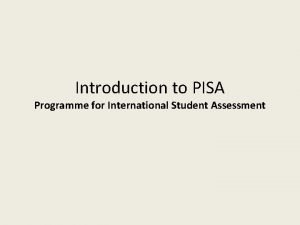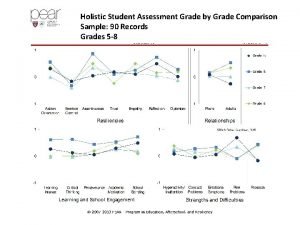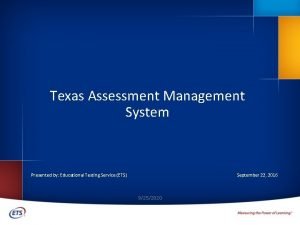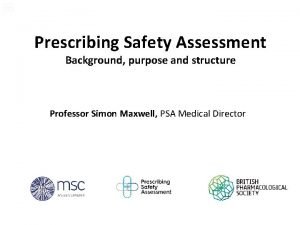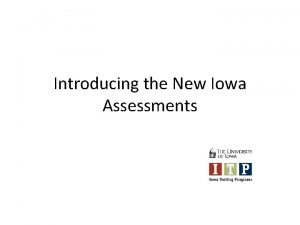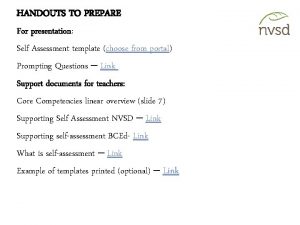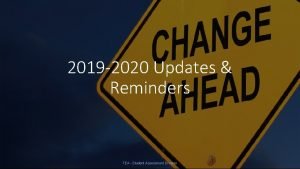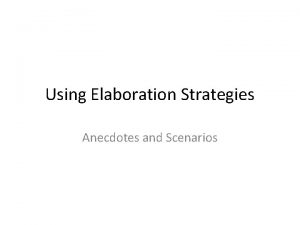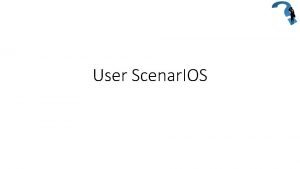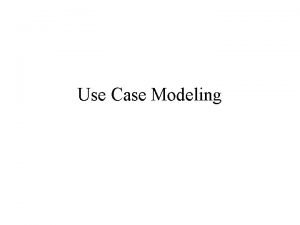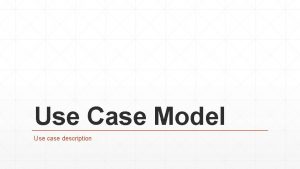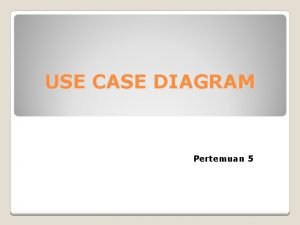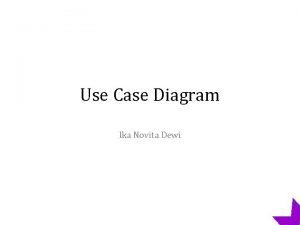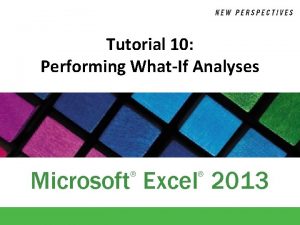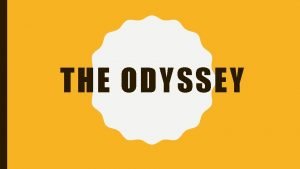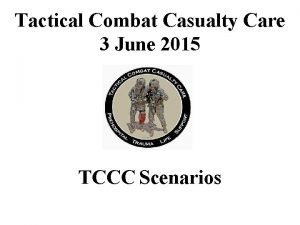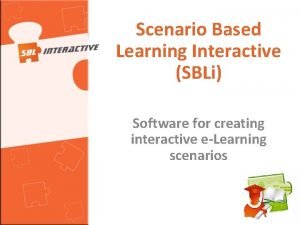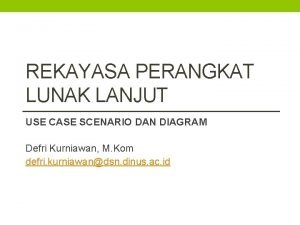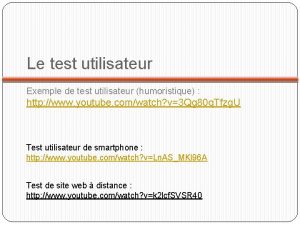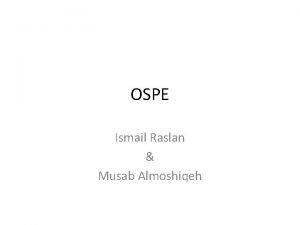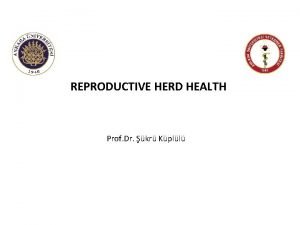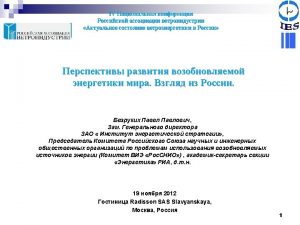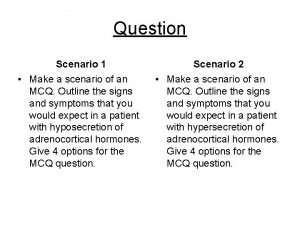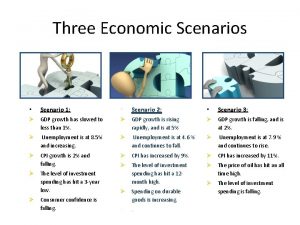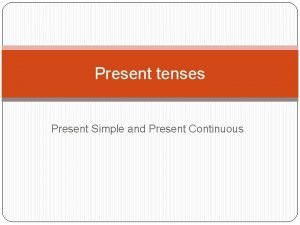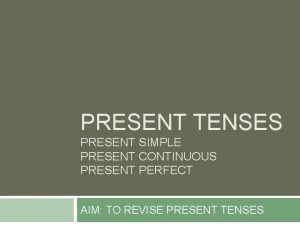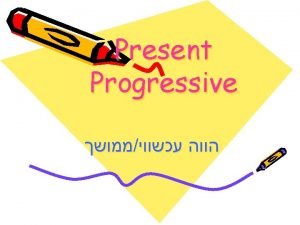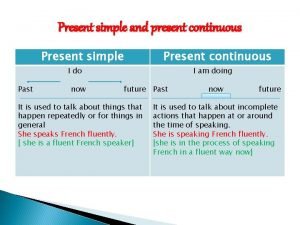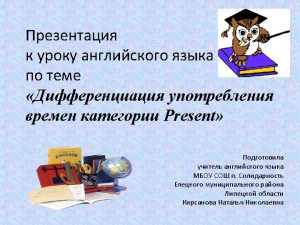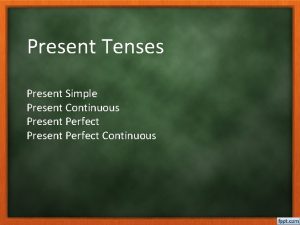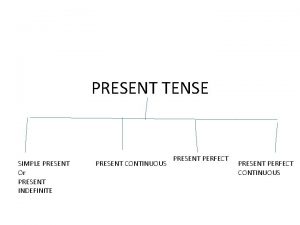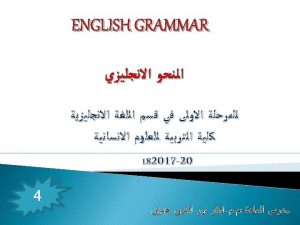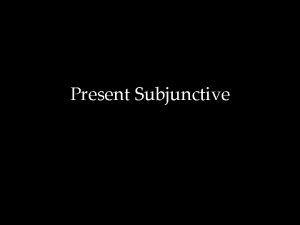Present scenario ClinicalPractical assessment A student may get

























































- Slides: 57


Present scenario: Clinical/Practical assessment A student may get: ØPractical of B. P. examination ØHemoglobin estimation by Sahli’s method ØDetermination of vital capacity spirometery. ØPerimetry of right temporal vision ØClinical examination of facial nerve Ø Gangrene Ø Hydrocele Different students gets Different exercise of Different contents.

Intra Examiner variability: Student is assign task of taking BP of Hypertensive Patient (170/95) Student follows most of the standard steps of BP measurement & reports BP as 160/80 Examiner 1 5/10 marks Examiner 2 0/10 marks

What is solution ? Task of BP measurement may be brocken down into various component & procedure is observed. No 1 2 3 4 5 6 7 Examination Yes No Explained procedure to the patient Checks the BP instrument for leakage Applied BP cuff properly Allow the Pt to rest before measurement Checked the systolic BP by palpatory method Measured the BP by Auscultatory method Matching of the result Total 1 1 1 0 0 0 2 3 10 0 0

This is OSCE/OSPE

Objective Structured Clinical Examination (OSCE) & Objective Structured Practical Examination (OSPE) Dr. G. U. Kavathia Asso. Professor in Microbiology P. D. U. Govt. Medical college, Rajkot.

LEARNING OBJECTIVES OF THIS SESSION: : Ø Ø Definition of OSCE/OSPE. General outline of OSCE/OSPE Station profile of OSCE/OSPE Advantage & disadvantage of OSCE/OSPE

DEFINITION: OSCE is basically an organized framework consisting of multiple stations around which student rotates and at which student performs and are assessed on specific tasks. Each task is broken down in to its various components. Each components are examined using check lists prepared in advance

OSCE Objective : examiners use a checklist for evaluating the trainees Structured: trainee sees the same problem and performs the same tasks in the same time frame Clinical Examination: the tasks are representative of those faced in real clinical situations

PURPOSE OF OSCE To make the Evaluation System as Reliable & Valid as possible Ø To Eliminate Variability (Examiners & Patients) Ø

BACKGROUND Started in 1972 Dundee, Scotland by R. Harden and F. Glesson Began with OSCE OSPE Now used in over 50 countries Used in many disciplines, UG as well as PG evaluation. It may be requirement of MCI in near future.

OSCE The clinical competence is broken down in to its various components e. g. taking a history / auscultation of heart / interpretation of ECG or coming to a conclusion on the basis of the findings. Each component is the objective of one of the stations in the examination

Miller’s Pyramid Does Shows how Knows Performance assessment in vitro: OSCEs OSPE

Important terminologies: Station: each task assigned to the student is termed as a station • Procedure Station • Question stations • Rest Station • Linked Station

Formulating OSPE Supplementation of station with Ø Graph Ø Ø Ø Ø Diagram Chart Table Specimen Animal Normal subject/Patient/Simulated Pt. Mannequin

Formulating OSPE Instruction to examinee Checklist is the most important component of OSCE/OSPE

GENERAL OUTLINE : • Skill to be tested is given in form of a specific question • Each question is a station • For each station a check list is prepared in advance • Check list prepared by breaking the skill to be tested into its vital components.

CONDUCTING OSCE / OSPE v. Student rotates round a number of stations – about 20 v. Spends specified time on each station (510 minutes) v. On a signal (e. g. bell) moves to the next.

SPECIMEN & QUE. HISTORY QUE. ON ST. 1 1 2 3 Que. ON ST. 3 Rest 4 5 HISTORY 20 ON 6 QUE. ST. 5 INSTRU. & QUE. 19 QUE. ON ST. 17 EXAMINE CHEST EXAMPLE OF OSCE 18 7 EXAMINE ABDOMEN ANS. -Q. ON ST. 7 NEURO EXAM. 17 8 QUE. ON ST. 15 16 9 CT SCAN CVS EXAM. 14 15 LAB DATA 13 INSTRU. & QUE. 12 QUE. ON ECG 11 ECG 10 ANS. -Q ON CT 19

PROCEDURE STATION e. g. Taking history of a patient Examine eye of a patient QUESTION STATION • Questions related to finding • Interpretation of lab report etc. 20

e. g. 1 History taking / Examining a patient - Examiner is present - Examiner Uses a check list to record the performance of the students. e. g. 2 Chest X-Ray/CT Scan inspection etc. . - No examiner - Student asked about his findings & interpretation at the next question station. 21

OSCE Competencies tested ØClinical competencies Ø Procedural skills Ø Communication skills including attitude Ø Psychomotor skill Ø Observation Ø Interpretation 22

PROCEDURE STATION: HISTORY TAKING Station No: This patient complains of ‘Stomach Pain”. Obtain a detailed & relevant history from him (Time : 10 Minutes)

PROCEDURE STATION: HISTORY TAKING Station No: Examiners check list Roll No: This patient complains of ‘Stomach Pain”. Obtain a history from him Marks for each. Key keypoints point in history) Key points in (0. 5 History Marks in History Marks Occupation Pain type Site Radiation of pain Relieving factor Aggravating factor Appetite Nausea, Vomiting Malena Family history Drug history Smoking Weight loss Alcohol TOTAL

PROCEDURE STATION: ABDOMINAL EXAMINATION Station No: Carry out the abdominal examination of patient (Time: 10 Minute) 25

PROCEDURE STATION: ABDOMINAL EXAMINATION Station No: Examiners check list Roll No: ( 0. 5 marks for each point of examination) Abdominal examination Made the Pt comfortable Marks Abdominal examination Mark s Percussion: Establish Rapport Liver Inspection: Spleen Position of doctor Shifting dullness Backside Auscultation Hernial sites Palpation: Starting point Gentle Total

QUESTION STATION: AFTER PHYSICAL EXAMINATION Station: Roll No: Answer the following questions regarding the abdominal examination you have just performed. (Time 10 Minutes) (Write Y for Yes, N for No in response box) No. Question Response Marks a The flanks of abdomen were full b The abdomen is diffusely protuberant c There is a scar mark in right iliac fossa d Prominent veins are present on the back e The right kidney is palpable f The left kidney is palpable g The spleen is palpable h There is a bruit heard in the epigastrium i The liver is palpable 27

KEY FOR QUESTION STATION NO: No. Question Correct Response Marks a The flanks of abdomen were full Y 1 b The abdomen is diffusely protuberant N 1 c There is a scar mark in right iliac fossa Y 1 d Prominent veins are present on the back Y 1 e The right kidney is palpable N 1 f The left kidney is palpable N 1 g The spleen is palpable N 1 h There is a bruit heard in the epigastrium Y 1 i The liver is palpable Y 1 J There is a fluid in the abdomen Y 1 28

PROCEDURE STATION: PHYSICAL EXAMINATION Station No: Carry out a neurological examination of lower limbs excluding sensation & coordination (Time: 10 Minutes)

PROCEDURE STATION: HISTORY TAKING Station: Examiners check list Roll No: Carry out a nerological examination of lower limbs excluding sensation & coordination Examination Marks Examination Mark s Inspection of legs Test for tone Test for clonus Test power-Ankle Test power-Knees Test power-Hips Test reflexes-Ankles Test reflexes-Knees Test reflexes -planter TOTAL Satisfactorily: 0. 5 Marks Attempted but not satisfactorily: 0. 25 Marks Not attempted: 0 Marks

QUESTION STATION: AFTER PHYSICAL EXAMINATION Station: Roll No: Answer the following questions about the patient you have just examined. (Time: 10 Minutes) (Write Y for Yes, N for No in response box) No. Question a Inspection reveals muscle wasting in left leg. b The tone in the left leg is decreased. c Flexion power at left knee is decreased d Muscle power at the left ankle is decreased e The knee jerk on left side is increased f The ankle jerk on left side is increased g Clonuses is present at the left ankle. h The left plantar reflex is flexor i The signs in the left leg are those of an Respons Mark e s 31

KEY FOR QUESTION STATION NO: No. Question Respons Mark e s a Inspection reveals muscle wasting in left leg. N 0. 5 b The tone in the left leg is decreased. N 0. 5 c Flexion power at left knee is decreased N 0. 5 d Muscle power at the left ankle is decreased N 0. 5 e The knee jerk on left side is increased Y 0. 5 f The ankle jerk on left side is increased Y 0. 5 g Clonuses is present at the left ankle. Y 0. 5 h The left plantar reflex is flexor Y 0. 5 i The signs in the left leg are those of an upper motor neuron lesion Y 0. 5 Total 4. 5 32

PROCEDURE STATION: ECG EXAMINATION Station No: Read the given ECG & write your observation (Time : 10 Minutes) 33

QUESTION STATION: AFTER ECG EXAMINATION Station No: Roll No: Answer the following questions about ECG you have just examined (Time 10 Minutes) 1. What is the diagnosis of ECG on previous station 2. What are the four likely immediate complications of this 3. What are the two late complications 4. What are the four most relevant risk factors for this 34

CHECK LIST FOR QUESTION STATION NO: No. Question Mark s 1 2 3 4 Acute anterior wall MI Sudden death, Acute LVF, Cardiogenic shock, Arrythmias Cardiac failure, Post MI angina Age, heredity, obesity, smoking Total 5 2 10 35

1. Interpretation of Patient’s charts / Lab. Investigations : Record of temperature B. P. Chart Chest X-Ray. Biochemical / Hematological report Respiratory function report 3. Instruments 4. Specimens 5. Fundus examination 36

SPECIMEN & QUE. HISTORY QUE. ON ST. 1 1 2 3 Que. ON ST. 3 Rest 4 5 HISTORY 20 ON 6 QUE. ST. 5 INSTRU. & QUE. 19 QUE. ON ST. 17 EXAMINE CHEST EXAMPLE OF OSCE 18 7 EXAMINE ABDOMEN ANS. -Q. ON ST. 7 NEURO EXAM. 17 8 QUE. ON ST. 15 16 9 CT SCAN CVS EXAM. 14 15 LAB DATA 13 INSTRU. & QUE. 12 QUE. ON ECG 11 ECG 10 ANS. -Q ON CT 37

EXAM VENUE

SIMULATED PATIENT(EXAMINATION)

ADVANTAGES OF THE OSCE All components of clinical Exams are assesed So More Valid examination Can be used with larger number of students Reproducible Components of clinical Skills & standards of competencies are predetermined So Objectivity & Reliability is higher The variable of the examiner and the patient are to a large extent removed

DISADVANTAGES OF THE OSCE Knowledge and skills are tested in compartments & not tested in ability to look at the Pt. as a whole, So long case may also needed The OSCE may be demanding for both examiners and patients More time in setting it up

42

Adaptation of OSCE to be applied for evaluation of skills in preclinical and paraclinical subjects. v Basic format remains same i. e. procedure stations and question stations. v Can be used as supplement to different method of evaluation 43

OSPE : PROCEDURE STATION Station No: You are provided a spirometer. Determine your vital capacity. (Time: 10 Minutes) 44

OSPE : PROCEDURE STATION Station No: Roll No: Examiners check list You are provided spirometer. Determine your vital capacity. No Examination Yes No 1 Does he check the spirometer for leakage ? 1 0 2 3 4 5 Mouth piece inserted properly Nose clipped properly Does he take a few normal breaths before Determining vital capacity ? 1 0 1 0 6 7 8 9 Takes a deep inspiration Exhales maximally Takes the highest reading as the vital capacity Determines two-stage vital capacity 1 0 1 0 Total 10 45

OSPE : QUESTION STATION 46

QUESTION STATION: Roll No: Station No: Identify parasite specimen & Answer the following questions. (Time 10 Min. ) No. Question a Identify specimen: b Write mode of transmission in human. c Write type of anaemias produce by it. Marks 47

KEY FOR QUESTION STATION: No. Question A Identify specimen: Adult form of Ankylostoma duodenale Write mode of transmission in human. By penetration of skin Write type of anaemias produce by it. Microcytic Hypochromic Write infectious form of this B C D Marks 2 1 1 48

DEMO. MOVEMENTS 1 PRESCRIPTION Q. ANS ON 2 X RAY 2 3 20 ON 6 QUE. ST. 5 EXAMPLE OF OSPE DOSAGE FORM 18 WITHDRAW FROM VIAL. 17 16 GROSS SPECIMEN 15. 4 VITAL 5 CAPACITY FDC 19 EVALUATE. QUE. ON ST. 15 IDENTIFY PART 14 LAB DATA 13 SLIDE (SPOT 7 NEURO EXAM. 8 QUE. ON ST. 7 NEUB. 9 CHAMBER 12 LAB DATA 11 Q. ANS ON 10 URINE 10 PROTEIN 49

v Determining vital capacity v Charging the Neubauer chamber for doing the RBC count v Recording blood pressure by auscultatory method v Preparing the blood smear from given sample v Identification of structures in the specimen (e. g. horizontal section of brain) or a dissected part or x ray v Interpretation of histological specimen 50

51

Ø Advance Planning Ø Organization The Day Before Examination Ø The Day Of Examination 52

(A) Advance Planning : 1) Examiners decide - What is to be examined. - Weightage to different components - Minimum standard to pass. 2) Briefing the examiners and concerned staff 3) Preparing the ward (venue) and ward staff 4) Selection and briefing Patients 5) Preparation of documentation including checklist, instructions for examiners and questions. 53

B) The Day Before The Examination: 1) Final check for preparations & arrangement in ward 2)Final documentation to be given to each examiner 54

C) The Day Of Examination Coordinator -1 hour prior Final check for arrangement Staff member brief the student All examiners have arrived and are at their correct station 55

GROUP WORK (TIME- 15 MINUTES) Each participant will prepare 1 station with following information 1. Station 2. Checklist 3. Discipline 4. Domain 5. Time 6. Marks 7. Object (material) & Subject required Group 1: Procedure station-OSCE Group 2: Question station- OSCE Group 3: Procedure station- OSPE Group 4: Question station- OSPE Only One from Each group will present in 56

THANK YOU
 Get in get on get off get out
Get in get on get off get out You're my kryptonite one direction
You're my kryptonite one direction Get up get moving quiz
Get up get moving quiz Get up get moving quiz
Get up get moving quiz Get up get moving quiz
Get up get moving quiz Get sequence get another sequence pseudocode
Get sequence get another sequence pseudocode Get focused get results
Get focused get results Germer
Germer Grading system deped
Grading system deped I write a letter now past continuous tense
I write a letter now past continuous tense Difference between present perfect simple and continuous
Difference between present perfect simple and continuous Cand se foloseste present perfect continuous
Cand se foloseste present perfect continuous Relative clause noredink
Relative clause noredink Simple present tense plural
Simple present tense plural Present simple present continuous present perfect
Present simple present continuous present perfect Present simple present continuous and present perfect
Present simple present continuous and present perfect Hci patterns may or may not include code for implementation
Hci patterns may or may not include code for implementation How did you...your last weekend
How did you...your last weekend What did you do in london last weekend
What did you do in london last weekend Uheaa contact
Uheaa contact Class maths student student1 class student string name
Class maths student student1 class student string name National student clearinghouse student tracker
National student clearinghouse student tracker Https://student.freckle.com/#/fact-practice
Https://student.freckle.com/#/fact-practice Good morning student how are you
Good morning student how are you Sls student learning space
Sls student learning space Perfect tense of get
Perfect tense of get Fly present perfect
Fly present perfect Past continuous past simple examples
Past continuous past simple examples Present tense of feed
Present tense of feed Simple present past future tense worksheets with answers
Simple present past future tense worksheets with answers Programme for international student assessment 2021
Programme for international student assessment 2021 Holistic student assessment
Holistic student assessment Tea student assessment
Tea student assessment Texasassessment management system
Texasassessment management system Different guidelines for effective student assessment
Different guidelines for effective student assessment To assess achievement at the end of instruction is
To assess achievement at the end of instruction is Psa prescribing test
Psa prescribing test Iowa staewide assessment of student progress
Iowa staewide assessment of student progress Student self-assessment template
Student self-assessment template Student assessment examples
Student assessment examples Kentucky alternate assessment student registration database
Kentucky alternate assessment student registration database Tea student assessment
Tea student assessment Piecewise function problem solving examples with answers
Piecewise function problem solving examples with answers Anecdote in a sentence
Anecdote in a sentence User scenario example
User scenario example Patient scenarios examples
Patient scenarios examples Use case details
Use case details Contoh diagram use case
Contoh diagram use case Use case scenario
Use case scenario How to create a scenario pivot table in excel
How to create a scenario pivot table in excel Describe the scenario that led prince paris to kidnap helen
Describe the scenario that led prince paris to kidnap helen Military 9 line
Military 9 line Tccc scenario cards
Tccc scenario cards Scenario based learning software
Scenario based learning software Contoh use case scenario
Contoh use case scenario Mystery shopper banks
Mystery shopper banks Exemple questionnaire test utilisateur
Exemple questionnaire test utilisateur Thinku know
Thinku know











